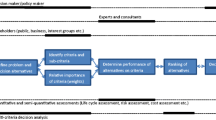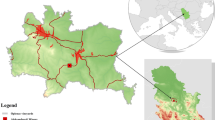Abstract
Errors in environmental resource management over the years have created pollution problems in some areas which are difficult to handle, regardless of the development of knowledge and technologies. This is particularly true in the case of soil pollution. The negative effects of persistent pollutants have been observed for a long time. For instance, lead and cadmium remain in the soil for centuries, during which time they are absorbed by plants and simultaneously cause secondary air pollution. The authors made an attempt to describe and assess the possible options of dealing with the problem of contaminated land in Katowice District. Considering the necessity of a multilateral approach, a pairwise comparison technique has been chosen as the most suitable to show the complexity of the problem. The different variants of actions aimed at preventing the pollutants from getting into the food chain were analyzed against a set of criteria, consisting of the following issues: time, cost, effectiveness, social acceptance, feasibility. The relative importance of actions were judged by the team of experts using the Saaty method. Also, a two-perspective assessment (the two different stakeholders), which involves considering the perspective of an owner of a piece of contaminated land and an ecologist has been performed. The results of comparative, multicriteria and multi-perspective assessment indicate the following:
- the best method for contaminated agricultural land management is willful and controlled cultivation,
- other recommended actions are deep ploughing and phytoremediation,
- there is not much acceptance for the other methods.
Similar content being viewed by others
References
Cunnigham, S.D. and Ow, D.W.: 1996, Promises and prospects of phytoremediation, Plant Physiol. 110, 715.
EPA: 1993, Remedation technologies screening matrix and reference guide, U.S. Environmental Protection Agency, Office of Solid Waste and Emergency Response, Washington, DC.
Gerdts, D.: 1992, Contaminated sites, a bottomless bag? A paper given on International Seminar on Contaminated Soils. Bilbao.
Janikowski, R.: 1993, Multi-criteria Decision Model as Tool of Environmental Management, Instytut Ekologii Terenów Uprzemysłowionych, Katowice, (in Polish).
Janikowski, R., Michaliszyn, B. and Krupanek, J.: 1994, Joint Implementation Projects Between the Netherlands and Poland, in O. Kuik, A. Peters and N. Schrijver (eds), Joint Implementation to Curb Climate Change. Kluwer Academic Publishers, Dordrecht.
Kucharski, R., Marchwinska, E. and Gzyl, J.: 1993, Agricultural Policy in Polluted Areas, Ecological Engineering 3, 299.
Kucharski, R., Janikowski, R. and Sas-Nowosielska, A.: 1996, Comparative Analysis of Policy Options in Polluted Areas, Proceedings Seminar on Guiding Principles for the Assessment of Soil Contamination, Katowice.
MEPNRF: 1991, National Environmental Policy of Poland. Ministry of Environmental Protection, Natural Resources and Forestry, Poland, Warsaw.
Saaty, T.L.: 1977, A scaling method for priorities in hierarchical structures, J. Math. Psychol. 15, 234.
Saaty, T.L.: 1980, The Analytic Hierarchy Process, McGraw-Hill, New York.
Seaver, D.A.: 1978, Assessing Probability with Multiple Individuals: Group Interaction Versus Mathematical Aggregation, University of Southern California, Social Science Research Institute, Research Rep. 78-3.
Vassil, D.A., Kapulnik, Y., Raskin, I. and Salt, D.: 1998, The role of EDTA in lead transport and accumulation by Indian mustard, Plant Physiol. 117, 447.
Author information
Authors and Affiliations
Corresponding author
Rights and permissions
About this article
Cite this article
Janikowski, R., Kucharski, R. & Sas-Nowosielska, A. Multi-Criteria and Multi-Perspective Analysis of Contaminated Land Management Methods. Environ Monit Assess 60, 89–102 (2000). https://doi.org/10.1023/A:1006152212344
Issue Date:
DOI: https://doi.org/10.1023/A:1006152212344




